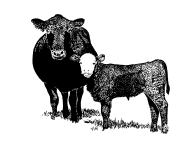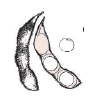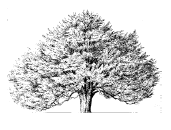

To send a message to an author, click on the author's name at the end of the article.
This Month in Ag Connection | Ag Connection - Other Issues Online
Dr. Craig Payne, MU Extension State Veterinarian, has put together some information in regards to the FDA's (Food and Drug Administration) GFI (Guidance for Industry) #209. This document recommends two principals regarding cautious use of antimicrobials (including antibiotics) in food producing animals:

How does this affect cattle producers? A producer will need to have a VFD from their veterinarian so they can acquire a medicated feed product on their farm. A prescription will be required if it is a medicated drinking water product. Additionally, these products will only be available for control, prevention or treatment of disease and it will be illegal to use them for growth promotion or feed efficiency purposes. These label changes will not apply to ionophores, Rumensinr®, Gain-Pror® and Bovatecr®, because they are not considered medically important according to FDA. For more information contact the regional extension livestock specialist.
Source: Wendy Rapp, Livestock Specialist
This Month in Ag Connection | Ag Connection - Other Issues Online
Property can be owned several different ways in Missouri. Property can be owned solely or in different ways of concurrent ownership. Concurrent ownership means that more than one person owns an interest in the property at the same time. The forms of concurrent ownership are tenancies in common, joint tenancies with right of survivorship, and tenancies by the entirety.
Tenancy by the entirety is a form of ownership that can exist only between a husband and wife. Each spouse owns 100% of the ownership. Since each owns all of the property, the property cannot be sold without the consent of both spouses. Creditors of one of the spouses cannot go against entireties' property to satisfy the debt of the one spouse. Upon the death of the first spouse, the surviving spouse remains as the sole owner of the whole property.
Joint tenancy with right of survivorship (JTROS) can exist between any two or more persons. All of the joint tenants have to own equal shares in the asset. A joint tenant can sell or give away his or her interest during their lifetime, but the interest is not inheritable upon death to the heirs. Instead, when a joint tenant dies, the interest is automatically passed to and is divided equally among surviving joint tenants. The last person alive becomes the owner of the entire property. Joint tenancy is usually created by the words "John Doe and Jane Doe, as joint tenants, with right of survivorship, and not as tenants in common."
Tenancy in common exists when two or more persons own an undivided interest in a property. The owners do not have to own equal portions of the property. A distinguishing feature of tenancy in common is that it is inheritable. The owner can sell, give away, or pass on interest to his/her heirs. The word "and" and sometimes "or" between owners' names creates tenancy in common.
It is extremely important to know how your property is titled. The method by which titles are held can have important estate planning implications. Many times heirs discover property that was assumed jointly owned by parents only lists one parent on the title. Even if the deceased has a legal will or trust, the title of an asset actually takes precedent over the will or trust and may force assets to be divided differently than intended. For example, a father and son operate a family business together where assets are owned as joint tenancy. The father is a widow and expects to die before his son, who has a wife and four children. The father plans for his assets to pass to his son. However, what if the son dies first? All of the son's interests in the joint tenancy assets will go to the father, leaving the wife and four children out of the inheritance of this property regardless of what the will says. Titles should be reviewed whenever there is a change in marital status, change in number of children, or a death in the family. It is also important to review non-titled assets such as machinery, livestock, and personal assets. Taking the time to review the titles of assets can help to alleviate problems down the road.
Source: Karisha Devlin, Ag Business Specialist
This Month in Ag Connection | Ag Connection - Other Issues Online

Recent reports of 100 plus bushel soybeans have some producers wondering about using nitrogen fertilizer on soybeans to enhance yields. The soybean crop has a high requirement for nitrogen. The crop takes up nearly five pounds of nitrogen per bushel; and about 75% of that is removed in the harvested crop. It is estimated that nitrogen fixation provides 50 to 60 percent of the nitrogen. A small amount of nitrogen comes from atmospheric deposition, including some fixed by lightning. The remainder comes from the soil, either from that left over from fertilizing the previous crop or from soil organic matter mineralization carried out by soil microbes. Nitrogen fixation takes a lot of energy in the form of sugars (produced by photosynthesis in the crop). Estimates of the amount of energy this takes varies widely but seem to be about ten percent of the energy captured in photosynthesis according to Emerson Nafziger, University of Illinois crop sciences researcher. This would seem logical because while photosynthesis powers growth and yield, the crop might not be able to produce enough sugars to go around. Therefore, at extremely high yield levels potentially either yield will suffer and/or nitrogen fixation would be reduced. All of this leads to the question of whether adding nitrogen fertilizer would result in higher yields.
Research conducted at the University of Illinois added nitrogen fertilizer in a series of trials over several years. Yields ranged widely from in the 30s to nearly 90 bpa (bushels per acre). In only one case did adding nitrogen fertilizer significantly increase yield (by 6 bpa). Results found no relationship between yield level and response to nitrogen fertilizer and therefore provide no support for the idea that the higher the yield, the more response to fertilizer nitrogen. In fact, the study found yields above 70 bpa more likely showed yield decreases from adding nitrogen, though these differences were small and not statistically significant. The results do not show adding nitrogen fertilizer will affect soybean yields, but an increase cannot be expected. Nafziger also stated that soils may contain more nitrogen than we realize, especially under good mineralization conditions. It is also possible that the photosynthetic capacity of soybeans under field conditions is not fully understood and the plant may be able to do more than expected.
With no certainty on return on investment and the possibility of unused nitrogen becoming part of the mobile pool of soil nitrogen going into the fall, nitrogen application to soybeans increases both economic and environmental risks. If interested in applying nitrogen to soybeans, producers can put in strip trials on their farm to better understand it on their fields and with their growing/management systems. There are several reports of producers with extremely high yields using nitrogen so there may be something to it; more experience and testing to see what works for each producer will be necessary.
Source: Wayne Crook, Agronomy Specialist
This Month in Ag Connection | Ag Connection - Other Issues Online
The cold, snowy winter was difficult for plants, wildlife, and humans in Missouri. A lot of winter damage on evergreen trees and shrubs, particularly on boxwoods, junipers, pine, spruce, rhododendrons and azaleas and even eastern red cedar has been reported. Evergreen foliage continues to lose moisture during the winter months, particularly on windy or sunny days. However, once the soil freezes, the plant's roots are no longer able to absorb moisture. Foliage exposed to the drying effects of the sun and wind may eventually dry out and die. Last summer's dry weather may have made the evergreens more susceptible to desiccation injury.

While desiccation injury occurs during the winter months, the browning of the needles often doesn't occur until late winter or early spring. Damage is most often located on the south and west sides of evergreens. The brown needles on affected trees and shrubs have been destroyed and will eventually fall off. However, the vegetative buds on the damaged evergreens may still be alive. Live buds will break in spring and produce new growth. Evergreens that have sustained light to moderate damage may look much better by late spring. A light application of fertilizer in early spring and watering during dry weather will encourage new growth and speed recovery of damaged plants. Areas that are completely brown in early June are dead and should be pruned out. During drought or dry spells during the summer, keep trees watered. During the drought of 2012 many evergreen trees died from lack of moisture. Beautiful fifty foot spruce trees were dead by late fall. Not all trees have deep tap roots, some have shallow roots that make them more prone to drought stress. Apply mulch around trees to hold in moisture, keep out weeds and to prevent mower or weed trimmer damage.
The winter was also hard on roses, butterfly bushes and other ornamentals. Wait until June to do anything drastic or to remove them. Give them a chance to put on growth, or to be sure they are truly dead before removing them.
Some lawns received damage particularly around driveways and walkways where snow, ice and salt sat piled for weeks. These brown, dead areas of lawn will have to be reseeded. If you didn't get them seeded this spring, wait until fall. Typically late August through early September is the ideal time to reseed a lawn. When mowing the lawn, mow high. It is recommended mowing cool-season grasses such as fescue, to a height of at least three inches. Mowing high will prevent weed growth as it shades out weeds. It also creates a much thicker, denser lawn. If the lawn has a lot of weeds such as dandelions, it may be time to take a soil test. Weeds often indicate a soil imbalance. Usually the soil has an acidic pH. Raising the pH to a desirable level, 6.0-7.0 for lawns, will decrease the number of weeds. Soil samples can be taken to the county extension office.
The long, cold winter and snow caused serious problems for wildlife. They did not have access to food on the ground and rabbits and deer browsed on trees, shrubs, fruit trees, and landscape plantings. Trees that have been completely girdled have essentially been destroyed. Wrapping the trunk or applying pruning paint to the damaged area will not save the tree. Most affected trees will sucker from the base. However, since most fruit and ornamental trees are propagated by grafting, suckers which originate from the rootstock will not produce a desirable tree. If trees were wrapped for winter protection the wrap should be removed. Moisture and insects can get into the wrap and cause problems.
Source: Jennifer Schutter, Horticulture Specialist
This Month in Ag Connection | Ag Connection - Other Issues Online
August 5: Greenley Research Center Field Day @ Lee Greenley Research Center
August 26: Graves-Chapple Field Day @ Graves Chapple Research Center
August 27: Hundley Whaley Field Day @ Hundley Whaley Research Center
September 2: Delta Research Center Field Day @ Delta Research Center
September 4: Bradford Research Center Tomato Field Day @ Bradford Research Center
September 5: Goodwater Field Day - Cover Crops, Bioenergy & Sustainable Production @ near Centralia, MO
September 11: Southwest Center Ag Education Day @ Southwest Research Center
September 12: Southwest Center Field Day @ Southwest Research Center
September 16: Bradford Research Center Ag Education Day @ Bradford Research Center
September 23: Forage Systems Research Center Field Day @ Forage Systems Research Center
September 27: South Farm Research Center Showcase @ South Farm Research Center
October 2: Wurdack Ag Education Day @ Hugo Wurdack Research Center
October 3: Wurdack Field Day @ Hugo Wurdack Research Center
Publishing Information
Ag Connection is published monthly for Northeast and Central areas of Missouri producers and is supported by the University of Missouri Extension, the Missouri Agricultural Experiment Station, and the MU College of Agriculture, Food and Natural Resources. Managing Editor: Mary Sobba.